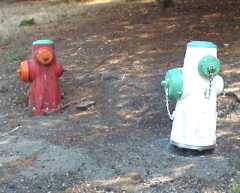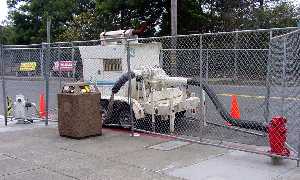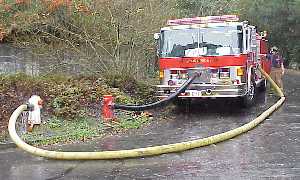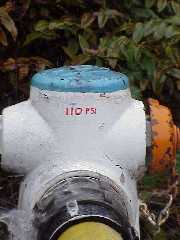|
 The Cascade System serving the Oakland,
Berkeley and Orinda hills consists of a series of pump plants and reservoirs.
Each distribution area, called a "pressure zone," is supplied by one
or more reservoirs. Water is pumped from each pressure zone to the
next highest zone by means of electric pumping plants. The pumping
plants are designed to refill the reservoirs each night and can
also be used to maintain the reservoirs at capacity during the day
during critical fire weather. (The reservoirs are sized to provide
at least two days domestic consumption and still hold the required
reserve for fire flows.)
The Cascade System serving the Oakland,
Berkeley and Orinda hills consists of a series of pump plants and reservoirs.
Each distribution area, called a "pressure zone," is supplied by one
or more reservoirs. Water is pumped from each pressure zone to the
next highest zone by means of electric pumping plants. The pumping
plants are designed to refill the reservoirs each night and can
also be used to maintain the reservoirs at capacity during the day
during critical fire weather. (The reservoirs are sized to provide
at least two days domestic consumption and still hold the required
reserve for fire flows.)
In the event of a prolonged power outage, EBMUD has portable generators
which can be used to power the pumps. In the event of a pump plant failure,
EBMUD has the capability of bringing in a portable pump with which to maintain
appropriate reservoir levels. On rare occasions these generators and pumps
have been put into use.
As an additional measure of redundancy, EBMUD has installed pairs of
fire hydrants at pumping plants and other strategic locations which are
called "Pump-Arounds." One hydrant is connected to the lower zone and
one hydrant is connected to the higher zone. In extenuating circumstances
water could be taken from the lower zone hydrant and pumped via external
means (e.g., a fire engine) to resupply the higher zone.
Due to sanitation considerations such external pumping would most likely
be provided by a "certified clean" EBMUD trailer pump, however under
catastrophic conditions which exceed EMBUD's immediately available resources,
a fire district engine could be pressed into service for this purpose.
(If a non-certified pump is used to pump water, the water quality will be
closely monitored, residents will be advised of the situation and the system
will be sanitized as appropriate once the crisis has passed.)
Fire District Procedure:
- If ordered or authorized to do so by an EBMUD Field Supervisor, the engine company
assigned to the pump-around shall take suction from the low pressure (red) hydrant
and prepare to discharge into the high pressure (white) hydrant.
- The Engineer shall determine the static pressure on the high pressure
hydrant prior to pumping by either noting the static pressure which is stenciled on
the hydrant or taking a gauge reading prior to pumping.
- The Engineer shall maintain a pump pressure of 10 p.s.i. above the static pressure
by means of setting the engine's pressure governor or relief valve prior to flowing
water.
- Greater pressure may damage water system piping
- Less pressure may allow water to "drain" from the higher zone to the lower zone
- During high volume demands the engine may not be able to maintain the higher pressure,
so the engine speed shall be regulated as necessary with the governor or relief
valve providing pressure limiting protection when demand decreases and discharge
pressures increase.
- EBMUD shall be notified immediately upon termination of the pump-around operation so
that appropriate testing of the water system for sanitary purposes can be expedited.
EBMUD trailer pump connected to a pump-around set in Oakland, CA

Photo by Danny Barlogio
|
Normal static pressure should be stenciled on the hydrant being pumped into.
Otherwise the engineer should note the pressure on the engine panel gauge before opening
the engine's discharge valve.

|

|
The evolution shown above would be put into effect if a fire occurred
in this pressure zone while the reservoir was out of service for repairs.
During fire district training sessions no water is actually introduced into the system
by the fire engine as we don't want to accidentally introduce contaminates into the municipal
water system. If in an emergency the pump-around had to be made using a non-sterilized
pump, a "boil water" advisory would be issued until the affected water mains
could be flushed and tested for purity.
|
|
 The
The 

